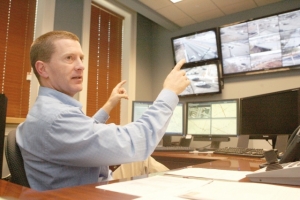Spying on the city's traffic signals
By Ty Johnson
Published in News on January 17, 2012 1:46 PM

Allison Carter
Bobby Croom talks about the monitors that allow him to view traffic around Goldsboro. The traffic cameras are placed to view Royall Avenue and other heavily traveled roads. The cameras can be rotated and have zoom capability.
Bobby Croom's commute from Wilson to his City Hall office takes him down Interstate 795 to Ash Street, so it's not likely the traffic signals on Wayne Memorial Drive and Berkeley Boulevard would have much effect on him.
But they do.
"All these signals concern me," he says in the glow of nearly half a dozen flat-screen televisions on the wall of his office, all showing a different intersection in Goldsboro.
As the city's traffic engineer, Croom is in charge of all he sees, studying the traffic patterns through a dozen closed-circuit cameras across the city during an observation period that will soon lead to him having control of the city's commuter flow along its two busiest corridors.
Drivers across the county who pass through Goldsboro have no doubt noticed that the traffic signals in town operate separately from one another such that on any given drive down certain corridors, they can be stopped by all, some or no red lights.
A new system, which has already been installed but won't be passed over from the state Department of Transportation to Croom until February, will allow him to alter the flow of traffic lights on Berkeley Boulevard and Wayne Memorial Drive to better match the tides of traffic in and out of the city.
The system, connected by a collection of wireless radios, dial-up modems and 41 miles of fiber optic cables, will be run from Croom's office where the traffic pattern software will manage lights according to an algorithm designed by NCDOT.
"We'll try to make it as safe and efficient as possible," he said, adding that gas savings and a decrease in pollution would come as a result of the system's implementation as well.
The plans will begin being used in the beginning of February, he said, and will be tweaked to ensure they apply in the real world just as the engineers hope they will.
The decision to focus first on Wayne Memorial Drive and Berkeley Boulevard was an easy one, Croom insists, since those roads see the most amount of traffic congestion.
Croom said a large impact will be felt by those who frequent Wayne Memorial Drive, but cautioned that the sheer amount of traffic would prevent Berkeley Boulevard from becoming a stop-free ride.
"Wayne Memorial will see the most benefit, with the hospital, community college, eateries and Starbucks. It will help with congestion there," he said, adding it would also be a benefit when the new U.S. Highway 70 Bypass is fully opened.
The amount of side streets on Berkeley Boulevard makes it difficult to manage, he said, adding that work to align streets -- especially at the Royall Avenue and Carver Heights Road intersection -- would help in the future.
"There's a lot of opportunity there to improve," he said.
And he'll oversee the entire project as the city's first traffic engineer. Croom, a native of Lenoir County, was hired last spring and has overseen the installation of the project since coming aboard. The plans will see the city's control and monitoring of traffic signals grow from 20 intersections to more than 120 during the course of the project.
A graduate of North Carolina State University, Croom has worked as the traffic systems analyst in Raleigh and was Asheville's traffic engineer for three years before coming to Goldsboro.
Croom and his wife, Monica, have two daughters, Sofia, 8, and Olivia, 5.
